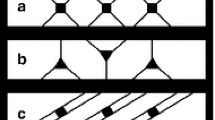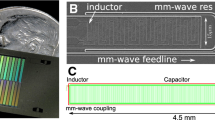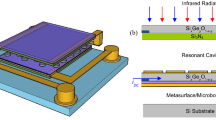Abstract
We have built and tested 32-element linear arrays of absorber-coupled transition-edge sensors (TESs) read out with a time-division SQUID multiplexer. This detector/readout architecture is designed for the background-limited far-IR/submm spectrograph (BLISS) which is a broadband (35–433 \(\upmu \)m), grating spectrometer consisting of six wavebands each with a modest resolution of R \(\sim \) 700. Since BLISS requires the effective noise equivalent power (NEP) of the TESs to equal 1 \(\times \) 10\(^{-19}\) W/Hz\(^{1/2}\), our detectors consist of very long (1–2 mm), narrow (0.4 \(\upmu \)m), and thin (0.25 \(\upmu \)m) Si\(_{x}\)N\(_{y}\) support beams that reduce the thermal conductance G between the substrate and the optical absorber. The thermistors of our lowest noise TESs consist of iridium with \(T_{c}=130\) mK. We have measured the electrical properties of arrays of these Ir TESs with various meander and straight support beams and absorber shapes and found that G is \(\sim \)30 fW/K (meander) and \(\sim \)110 fW/K (straight), the electrical NEP is 2–3 \(\times \) 10\(^{-19}\) W/Hz\(^{1/2}\) (meander and straight), and the response time \(\tau \) is 10–30 ms (meander) and 2–5 ms (straight). To reduce spurious or “dark” power from heating the arrays, we mounted the arrays into light-tight niobium boxes and added custom L/R and L/C low-pass chip filters into these boxes to intercept dark power from the bias and readout circuit. We found the average dark power equals 1.3 and 4.6 fW for the boxes with L/R and L/C chip filters, respectively. We have built arrays with \(T_{c}= 70\) mK using molybdenum/copper bilayers and are working to lower the dark power by an order of magnitude so we can demonstrate NEP\(~=~1~\times \) 10\(^{-19}\) W/Hz\(^{1/2}\) with these arrays. PACS numbers: 85.25.Pb; 95.85.Gn; 95.85.Fm; 63.22.\(+\)m





Similar content being viewed by others
References
C.M. Bradford et al., Proc. SPIE 6265, 62650U (2006)
D. Hughes et al., Nature 394, 241 (1998)
See http://www.ir.isas.jaxa.jp/SPICA/ for details
See http://safir.jpl.nasa.gov/index.shtml for details
M. Kenyon et al., Nucl. Instrum. Methods Phys. Res. Sect. A 559, 456 (2006)
M. Kenyon et al., J. Low Temp. Phys. 151, 116 (2008)
A. Beyer et al., IEEE Trans. Appl. Supercond. 23, 2100104 (2013)
A. Beyer et al., IEEE Trans. Appl. Supercond. 21, 199 (2011)
M. Kenyon et al., IEEE Trans. Appl. Supercond. 19, 524 (2009)
A. Beyer et al., Proc. SPIE 7741, 774121 (2010)
A. Beyer et al., J. Low Temp. Phys. 167, 182 (2011)
Acknowledgments
This research was carried out at the Jet Propulsion Laboratory and Caltech under contract with the National Aeronautics and Space Administration.
Author information
Authors and Affiliations
Corresponding author
Rights and permissions
About this article
Cite this article
Kenyon, M., Beyer, A.D., Bumble, B. et al. Toward a Detector/Readout Architecture for the Background-Limited Far-IR/Submm Spectrograph (BLISS). J Low Temp Phys 176, 376–382 (2014). https://doi.org/10.1007/s10909-013-1020-5
Received:
Accepted:
Published:
Issue Date:
DOI: https://doi.org/10.1007/s10909-013-1020-5




